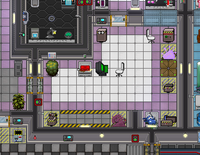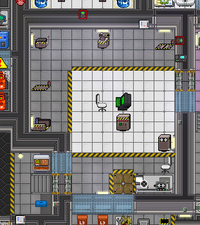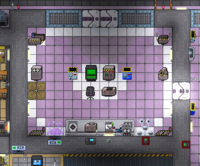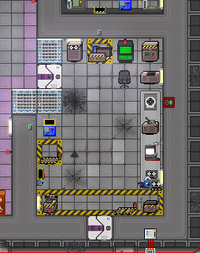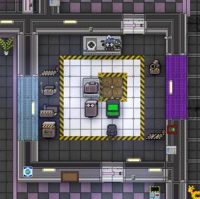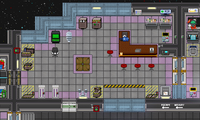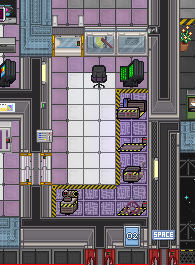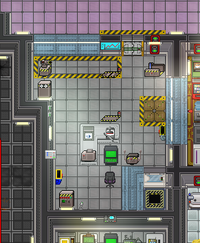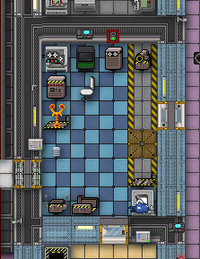Artifact Research: Difference between revisions
m whitespace deletion, comment that I forgot to remove |
m consistency |
||
| Line 233: | Line 233: | ||
|- | |- | ||
!Electricity | !Electricity | ||
| Electrifying | | Electrifying the artifact with the electrobox. | ||
| Zapping the artifact with a [[Security Objects#Stun Baton|stun baton]] or [[Medical Objects#Defibrillator|defibrillator]], or EMPing it. | | Zapping the artifact with a [[Security Objects#Stun Baton|stun baton]] or [[Medical Objects#Defibrillator|defibrillator]], or EMPing it. | ||
|- | |- | ||
Revision as of 05:44, 19 March 2021
| Artifact Research | |
| Location | |
|---|---|
|
Alien saxophone lab. | |
| Artifact Research | |
| Location | |
|---|---|
|
Alien saxophone lab. | |
| Artifact Research | |
| Location | |
|---|---|
|
Alien saxophone lab. | |
| Artifact Research | |
| Location | |
|---|---|
|
Alien saxophone lab. | |
| Artifact Research | |
| Location | |
|---|---|
|
Alien saxophone lab. | |
| Artifact Research | |
| Location | |
|---|---|
|
Alien saxophone lab. | |
| Artifact Research | |
| Location | |
|---|---|
|
Alien saxophone lab. | |
| Artifact Research | |
| Location | |
|---|---|
|
Alien saxophone lab. | |
| Artifact Research | |
| Location | |
|---|---|
|
Alien saxophone lab. | |
Artifact Research is the branch of Research concerned with the identification and possible testing of dangerous, unpredictable artifacts of extraterrestrial origin. An artifact is a large or handheld item of non-Nanotrasen origin whose function is unknown. These artifacts are usually dug up by miners, and the station always starts with two in the Artifact Lab and several littered around maintenance tunnels. Others can be found in the debris field and adventure zones, or purchased from certain traders.
Flavors of Artifacts
| Artifact | Image | Description | Unactivated Name Examples | Activated Name Examples |
|---|---|---|---|---|
| Eldritch | The "Abomination", often cited in mythos. An unknown race, possibly not even from this dimension, however their presence is perpetual. Even looking at the artifact makes scientists feel uneasy. Experiment with your peril. | evil-looking thorns lurid steele |
blood of vile yncactath has'ncacthoth's ichor will of cthoolac | |
| Wizard | Wizards, while more of a federation than a race, have very unique technology. Complicated machines, made to look archaic as to give the impression that it is magical, however this magic has been mostly debunked by nanotrasen researchers. | ostentatious trophy regal cane |
pearl treasure of eminence opal jewel of splendor ebon favor of majesty | |
| Martian | Originates from the temperamental aliens from Mars. The Martians have advanced in organic and terraforming technology, and have used these flesh based machines to advance rapidly throughout the galaxy, much to the threat of every other race. | squishy clump gooey organ |
ossumuscular depressor physiometabolic regenerator neurogenetic suppressor | |
| Forerunner | Also known as Precursor, the true name and face of this race is shrouded in mystery. Carbon-dating reveals that the artifacts are millenniums ancient, and the creators of these machines are possibly extinct. What is known however, is they hold great power. | antique gizmo quirky device |
ultramolecule synchroniser tachyon fuser atom synchroniser | |
| Robot | A race of silicon based sentients, often confused as machines themselves. Much further advanced than the human race due to their mass consciousness, their machinery has been fine tuned to suit their needs, and therefore is rigidly electronic based. | cold menhir sharp-edged appliance |
unit epsilon-x 536 unit sigma-z 304 unit tau-k 712 |
Running gptio
Discovering an artifact's effects takes more than repeatedly poking it (although this helps in a fashion). Using the DWAINE terminal, you can advance the station's knowledge of artifacts and their properties and make your analysis more precise. To do this, you must:
- Insert your card into the terminal, and type term_login
- Type cd /mnt/artlab to move to the default location of the artifact research tape.
- Decide which test to run, pop the artifact in the corresponding machine, adjust the variables as you see fit, and activate the machine (using the commands below).
- Troubleshooting: If you can't get this to work, it's likely your terminal isn't connected to the research mainframe. In this case, type term_ping, find the 8-character net ID labelled PNET_MAINFRAME and run the command connect mainframe_id
- If even this doesn't work, it's likely there's a problem with the mainframe itself, the databank that runs gptio, or the wiring that connects it all. Contact your system administrator and hope it's a simple as turning power back on in the Computer Core.
Important commands
- gptio list
- Lists the currently connected devices and their IDs.
- gptio activate device-id
- Activates a device. This can be anything from shooting an object across the room to irradiating whatever is in the x-ray scanner. Note: Some devices, like the electrical tester, don't like being activated without something loaded.
- gptio deactivate device-id
- Some devices don't automatically deactivate after a short amount of time. You'll need to use this command to make them safe to touch.
- gptio sense device-id
- Instruct the device to take readings about its state and the state of whatever object is inserted into it.
- gptio read device-id
- Retrieve the data generated by gptio sense. Note, this will report the state from when you last sense:d, not the state right now.
- gptio info device-id
- Show the status of a device, including if it's active, if it's an "enactor" and/or a "sensor" and maybe most importantly what variables it has to mess with.
- gptio peek device-id variable-name
- Read the value of a variable. Note that most if not all variables can be read on the device itself.
- gptio poke device-id variable-name value
- Change the value of a variable.
Working Artlab
The Devices
The artifact lab comes with five devices: Pitcher, impact pad, electric box, heater and x-ray scanner.
![]() The Pitcher (device ID: pitcher)
The Pitcher (device ID: pitcher)
- The pitcher is not for shooting artifacts, though that's fun too. You insert something for the pitcher to fire (say, a fire extinguisher), and the pitcher fires it at the artifacts on the impact pad.
- The pitcher has one variable, POWER, which goes from 0 to 100. Simple enough.
![]() The Impact Pad (device ID: impactpad)
The Impact Pad (device ID: impactpad)
- The impact pad is for putting artifacts on. Fire an item at the artifact and then read the sensor data-
- The pad has one variable, STAND, which is binary (0 or 1). Setting it to 1 extends a stand for putting handheld artifacts on.
- Two datapoints will be reported: Vibration amplitude and vibration frequency.
![]() The Electric Box (device ID: elecbox)
The Electric Box (device ID: elecbox)
- The electric box will run an electrical current through the artifact.
- It has two variables, WATTAGE (1-50) and VOLTAGE (1-100). Remember, Wattage = Current * Voltage, so "Selected current" will just be Wattage/Voltage.
- It returns three datapoints: Returned current, circuit capacity and interference.
![]() The Heater (device ID: heater)
The Heater (device ID: heater)
- The heater will heat the artifact, or cool it.
- It has one variable, TEMPTARGET (accepts 200-400 in Kelvin), which the actual temperature will slowly reach.
- The sensors will report current temperature, artifact temperature and whether the artifact responds to temperature at all.
![]() The X-ray Scanner (device ID: xray)
The X-ray Scanner (device ID: xray)
- The X-ray scanner will scan the artifact.
- It has one setting, RADSTRENGTH, which goes from 1 to 10 (multiples of 10%).
- You'll get a load of data back: Object density, structural consistency, structural integrity, special features of object and like the heater, whether it responds to radiation.
The dirty secret of Artlab is that each specific artifact always gives the same sensor data. So you can potentially know what a certain artifact does after analyzing it in the lab, but you'll still need to figure out how to activate it.
Analyzing sensor data
Vibration Amplitude and Vibration Frequency (Force)
- Something that has low returns for these categories is something that absorbs physical shock well - if its high, its probably made of something that reverberates a lot when struck, such as metal.
- Right now these are based entirely off the artifact's origin and thus aren't very useful at all
Test Voltage, Load Impedance, Circuit Capacity and Interference (Electricity)
- Test Voltage is just the voltage you have the electrobox set to.
- Load Impedance is how much of the electricity put into the artifact was returned to the electrobox. If you're getting back 100% of what you put in or close to it, you've likely got something that involves electrical charge on your hands.
- Circuit Capacity is how much electrical charge the artifact seems to be able to hold. Anything with this most likely has some kind of internal charge it draws on to power itself. The higher this is, the longer the artifact can do its thing without having to stop and recharge. However, sometimes artifacts can contain internal power cells which hold the charge - if this is the case, the artifact may return a very low value since the artifact itself is useless without its battery.
- Interference is how much the electrical charge is being disrupted when ran through the artifact. Something with a lot of this is probably some really goddamn weird thing. It's normal for any kind of artifact to have a little of this though.
- Other things can affect these readouts - certain artifact origins can skew the results a little, and if an artifact is faulty it can disrupt the capacity and interference readouts. The best way to figure this out is to take multiple readings and compare them - if your readings are all the same there's likely nothing wrong with it, but if they're inconsistent you might want to be cautious.
Current temperature, Artifact Temperature, Response to Heat (Heat)
- It only checks to see if the artifact responds above or below certain temperatures. This is useful to basically tell you this artifact will activate if you raise/lower the temperature some more
- The heater pad also has a details readout, which will give information on the artifacts features specifically to heat.
Density, Structural Consistency, Structural Integrity, Response to Radiation and Special Features (Radiation)
- Density is how dense the artifact's mass is. Readings above 10 mean the artifact is more likely to be something weird or something that can fuck with physical forces. Low density means the artifact is likely built to contain something else or is otherwise hollow/cavity-filled.
- Structural Consistency means how much of the artifact's internal structure is solid or similar. The higher this is, the less likely the artifact is to be something useful. Readings will always generally be fairly high though, but ones at or close to 100% are probably worthless. Remember - machines and biological things have lot of complex parts inside so they're not solid!
- Structural Integrity is how "solid" the artifact is in terms of construction, is it very damage-resistant and well put together or is it something you could probably crush like a soda can? Very low readings can also indicate the artifact may have something wrong with it, such as it is damaged/malfunctioning/dangerous or what have you.
- Response to Radiation is how much the artifact responds to being irradiated. You'll have to play around with the radiation strength setting on the equipment to get an accurate picture of what's going on here - the artifact's origin can muck with this reading sometimes. The stronger the response, the more likely it is the artifact is activated via radiation - you just need to find out the right amount to use.
- Special Features details anything that is paticularly unusual about the artifact's shape - these are mostly a hint towards what the artifact does.
...But I just wanted to know how do I get the artifact out of the damn device??
Click-drag from the machine onto the floor to remove an artifact that's inside of it.
Artifact Interaction
Artifacts can be interacted, and thus activated, through other ways than the devices in the laboratory. The various stimuli mentioned below can be used to substitute the various devices; however they do not give as much control as the dedicated machinery. This is worth noting because a certain amount, not just the presence, of a stimulus is needed to activate an artifact. ALL artifacts can be activated within artlab; external devices are not required, but having them tends to greatly reduce the tedium involved.
The correct mild stimulus in an artifact will give you a hint if you are on the right tracks to activate the artifact. You'll get something along the lines "The quirky contraption makes a faint noise."
It is possible to damage an artifact, this is down to too much stimulus. In addition to potentially destroying the artifact if too much damage is done, it can also cause them to develop faults and malfunctions, which are almost always a bad thing.
Artifacts will glow, shimmer and generally look turned on when activated. In addition, the name will change from a brief description of its appearance to its "real name", which is often something like "sapphire jewel of majesty", "unit tau-k 973", "meganeutron fuser ", "cardiogenetic regenerator " or "shubsoggoth's mandible". If the artifact produces a temporary effect like a Forcewall or Darkness upon being activated for the first time, in most cases it will only need a simple touch to activate again depending on the effect.
Stimuli
| Stimulus | Device-Based Methods | Other Methods |
|---|---|---|
| Carbon Touch | None. | Having the artifact be touched by any carbon-based life form. You use other people or monkeys as test dummies by grabbing them with Grab intent and clicking the artifact. Blobs also cause this stimulus- try politely asking a blob for help if you can't figure out how to touch something with your hand. |
| Silicon Touch | None. | Having the artifact be touched by a cyborg, or a cyborg arm. You can find arms in robotics, or in the guardbuddy room, which is usually close to or within the science department. |
| Force | Shooting objects at the artifact via the pitcher. | Hitting the artifact with just about anything that deals BRUTE will cause this stimulus, and throwing such objects will have a similar effect. Kinetic bullets and explosions also work, though take care not to miss and/or lose a limb. |
| Heat | Using the heater to expose the artifact to specific temperatures. | Burning the artifact with a lighter, welder, or similar will produce a hot stimulus. |
| Electricity | Electrifying the artifact with the electrobox. | Zapping the artifact with a stun baton or defibrillator, or EMPing it. |
| Radiation | Scanning the artifact with the X-Ray. | Certain chemicals (see below). EMPs also cause a small amount of radiation stimulus. |
| Data | None. | Smacking the artifact with a Thinktape (found in the artifact lab, and elsewhere) or a console circuit board. |
Chemical Stimuli
While not a stimulus type themselves, chemicals can produce a wide variety of stimuli. Radioactive chemicals produce a radiation stimulus, hot chemicals produce a hot stimulus, and cold chemicals produce a cold stimulus. Some chemicals even produce a random stimulus!
As a rule of thumb, the more of a chemical you use, the stronger a stimulus you'll get.
Possible Effects
So, what happens when you actually activate an artifact? That's the fun of it, it's entirely random. Aside from the artifact's size, you'll have no way of knowing just what it will do until you activate it. What we can tell you is what the potential abilities of the artifacts are:
Bulky Artifacts
These are giant-looking things that you can't pick up, only drag around. Note that pulling or pushing them doesn't count as a TOUCH stimulus, you must click it with an active hand for that. This lets you drag it around safely. You can also force someone to touch artifacts by putting them in an aggressive or higher grab (click on them with Grab intent, click on the grab to upgrade it) and then clicking on the artifact, triggering its effects. Obviously, don't wordlessly grab random people and force them to touch artifacts (especially if it's one of the harmful ones), or similar, unless you're an Antagonist.
| Artifact Type | Description |
|---|---|
| Forcefield Generator | The artifact will produce a shiny forcefield of varying size and duration. Until it powers down after a random amount of time, nothing short of teleportation will break through its stubborn walls. |
| Lamp | Emits a bright, permanent light. Harmless, unless you're a vampire or something. |
| Darkness | A cloak of absolute darkness will envelop the artifact and area around it, preventing any actions short of walking around in it until it powers down. Having Thermals or Mesons can make it easier to navigate. |
| Healer | One of the few benign artifacts you'll come across, touching it will heal all damage types. |
| Aura | Periodically, these artifacts will have a certain effect on an area around them. These can either heal all people nearby for a small amount, damage everyone nearby for a small amount, or Automatically water plant trays within a certain radius (This will not overfill plant trays.) All auras have the same activation method, so determine which one it is by standing near it for a while! |
| Prison | Not as bad as it sounds, the artifact will drag you into it and lock itself for a minute or two before spitting you out again. Handy for trapping people or jumping into for protection. These are one of the few artifact types that don't require activation, and will only do the "lit up" animation when someone is inside of it. |
| Human-to-Cyborg Converter | The above's much meaner cousin, this one pulls you in when you touch it and painfully turns you into a generic light Cyborg! It gibs your old body as well, losing you everything you had on your formerly fleshy self. If a Cyborg touches it, they'll receive a mysterious message declaring something like UPGRADE COMPLETE. You'll know one of these is kicking around somewhere on the station if you suddenly see a lot of borgs with weird names. You can always tell these apart from other large artifacts from their inspect message. ONLY Borgers will have a "Vaguely Foreboding" tag when inspected, so be careful not to touch them when testing and trying to activate them!
|
| Mutation | This silly artifact will give you a certain mutation when you touch it. Sometimes this is bad, other times it's beneficial! Usually they only last for a limited time either way. This is indicated by the "Eerie Light" message upon activation. |
| Injector | This picks a random cocktail of up to three chemicals and injects anyone who touches it. This is usually never good, though if you're careful and lucky enough you can harvest reagents from it; some very rare reagents can only be found from these. |
| Gravity | A mildly annoying artifact, this will either pull things towards it or push them away from it. |
| Noisemaker | Harmless, unless you consider the grating noises they make as "harm". These will incessantly play a random, looping sound until destroyed. Rarely, these noisemakers will also deafen and disorient nearby people for a few seconds, in addition to their normal effect. |
| Container | When activated and touched, this artifact will vanish and leave its contents behind, which can be anything from items to weapons to critters to mobs. Be on guard in the case of the last two! |
| Warp | Touch the artifact. Now go run off somewhere and wait a couple of minutes, and you'll suddenly be warped back to wherever the artifact is! This one doesn't need to be activated to work. You can tell these artifacts apart on activation as they will give no message when the sound file is played. |
| Bomb | If you see a message about an artifact "catastrophically overloading" or "intensifying its own gravity", and it starts vibrating, blaring alarms, and emitting light, GET RID OF IT IMMEDIATELY! This means that in two minutes the artbomb's going to detonate. During this time, you can click on the bomb with an appropriate activator artifact to halt the detonation and deactivate it, but you better be quick. At the end of those two minutes, you'll see messages about it reaching "critical energy levels" or starting to "collapse in on itself", meaning it's just about to detonate, so run.
There are four types with four different payloads.
|
| Turret | When these artifacts are activated they reveal an array of GUNS. The artifact will automatically 'turn' and shoot nearby people/monkeys. They deactivate after a while if there is nothing to shoot. Be warned, these can and will shoot you soon after you turn it on for the first time, so run away and come back after a while, the artifact will probably have turned off. |
| Wishgranter | Make a wish! When activated, a booming voice will give you a choice of either great wealth or great power. Depending on its mood (which to say, completely randomly), it may do exactly as you intended, bestowing great wads of credits or fabulous genetic powers (or a great power cell if you're a robot). Or it might just pull a literal genie and just kill you in suitably ironic (and irreversible) fashion. |
| Surgery | Replaces one of your limbs with a snazzy new robot limb when you click on it. Certain limbs will always be replaced with certain augmentations, and you can use it as many times as you'd like. Just have a few styptic patches ready. There are three types of this artifact. The first will replace limbs with robot limbs. The second type will replace limbs with Synthetic limbs, and the third type will swap out eyes, heart and butt for Cybernetic equivilents. |
| Generator | Click on it while it's over a wire (insulated gloves recommended) to connect it the station power grid, and it'll generate anywhere from 500 kW to 500 MW of electricity. Warning: This type of artifact can burst into flames/rumble, similarly to the TEG. Depending on the strength, it has the ability to hotwire. Placing directly on the grid can result in severe collateral damage. Should you wish to remove it, simply click on it again to disconnect it. |
| Air | Constantly pumps out a fair amount of one random gas, depending on the artifact family, at a random temperature, usually never beyond 0 to 620 Kelvin. These usually tend to emit oxygen or nitrogen, but they can emit any of the gases in the game, including plasma or even farts. Can be useful for repressurizing areas. |
| Evil Cloner | Hold your horses, it's unrelated to the Medical cloner (or its Syndicate version). When activated, if you touch this rare artifact, it'll create a copy of you (sans items) inside itself, and from there, one of the following happens:
The clone shares same AI as the one behind hellmonkeys, and so is quite apt at weapon usage. At the same, they're still a regular human (or human adjacent) and thus are still vulnerable to fire, poison, space, etc. Speaking of humans, you can't use this as a Critter, Cyborg, Ghostdrone, or some such. |
Hand-held Artifacts
Smaller artifacts that you can carry around. These will come with extra messages such as "having a handle to hold it by" to tell you it can be picked up.
| Artifact Type | Description |
|---|---|
| Self-Teleporter | Click the floor, any floor. VOOM! You are there. |
| Melee | Well yes, you could technically whack someone with any kind of handheld artifact, but these specific ones inflict a set amount of a certain damage type. You'll know if you have one of these if it makes a bizarre sound when you hit someone with it. These can be very powerful if RNG Favors you. Additionally, they can also inflict stuns similar in fashion to security batons, or very rarely, cause an insta-gib. Generally, test these on NPC's rather than yourself. |
| Gun | Like the Melee artifact, but ranged. It picks a random damage type, damage amount and number of bullets fired in one burst. Depending on how the RNG rolls, these can be amazingly deadly. Additionally, all Gun artifacts contain their own unique Small artifact power cell, which can be extracted by swapping its battery with another. Oftentimes these are considerably better than their on-station equivilents, with the added bonus of being self-charging. These powercells are not the same as the artifact cells which can be found outside of artifacts, and can only be used for battery powered equipment, rather than cyborgs and APC's. Note, that gun artifacts often come with side effects if you use them too much. These can come from self detonation, to injections of toxins, random teleports, or rarely, self-gibs. Careful not to spam too much! |
| Forcewall | Like the bigger artifact, but it only makes a wall in one direction. |
| Watering Can | More commonly called "artifact beakers" or simply "artbeakers", since that is how they are usually used. A Scientist's best friend, these things have obscene reagent limits and come pre-loaded with massive amounts of obscure chems (usually Saltpetre, which means happy days for any Scientist or Botanist). These can fit into any machine that a regular beaker can, and don't need to be activated before they can be used. Note that these do not have the "has a handle" message when examined, so you'll have to pay attention to whether it looks like it can be picked up or not. |
| Pitcher | Specifically, a beverage pitcher, meaning you can chug from it and put it into drink dispensers. In addition to the typical base alcohols and mixers you'd get from drink dispensers, these can contain a special selection of wild and crazy chemicals of questionable quality, such as Bombini, moonshine, and hairgrownium. The amount you drink from the pitcher with each sip is random, and, similar to artifact beakers, so is the pitcher's capacity, which is generally between 500 and 2000 units. |
| Magic | Casts a powerful magical attack. There is a lightning variant that zaps people, an ice variant that creates ice trails and freezes people into ice cubes, a fire variant that throws columns of flame, a sonic variant that stuns everyone within a certain radius, and a variant that randomly does one of the four. Has a cooldown between each use. These can be very deadly even to the user, so be careful with them! |
| Instrument | Click on it/activate it in-hand to play...something that can probably be called music. |
| Activator | Quite possibly the holy grail of artifact research, this can activate and deactivate any artifact of its type (Eldritch, Wizard, Martian, Forerunner, Robot), and sometimes every type. If you obtain this, then throw your hands up in the air you lucky bastard, because you are really goddamned lucky.
|
Tiny Artifacts
Similar to handhelds in that they can be picked up, but they'll look pretty small. They come with an extra "It kinda looks like it's supposed to be inserted into something." message when examined. These will already look activated when you find them.
| Artifact Type | Description |
|---|---|
| Cell | The ultimate power cell. Has an absurdly wide range of charge limits and can charge on its own without need of a charger. Occasionally, it may make concerning noises and leak certain chemicals, with higher capacity cells being more likely to leak. Most cells spill onto the floor, but, rarely, it is possible to get a cell that discharges into the air as a tiny smoke powder cloud. Martian cells tend to release organic-themed substances, Wizard cells very flashy and showy chems, Robot cells fuels and machine-related liquids, and Precursor literally any possible chem in the game, barring a handful of exceptions.
These always spawned activated and often low on charge. When deactivated, they lose all their charge, and their capacity drops to zero. |
Examining
For some artifacts, a good way of telling what they do can be ascertained simply by examining them! These artifacts will have special text the line after the generic "You have no idea what this thing is!"
- "It is covered in highly conspicious markings." Can be either a bomb, a turret, a gravity manipulator, or air artifact.
- "It looks vaguely foreboding." Steer clear of artifacts with this label: only human>cyborg converters have this examine text!
- "It appears to have a handle you can hold it by." Most handheld artifacts have this examine text. If you find one that doesn't, it's either an instrument, a beaker, or an activator.
- "It looks like it's supposed to be inserted into something." Ditto for tiny artifacts. If you find a handheld with this text, then it's definitely an activator, lucky you!
- "It is sparking." Similar to borging artifacts, only electrical generators have this examine text.
Alien Invasion
If you're a traitor with a penchant for the weird and are willing to play chicken with the RNG, then you're in for a fun time. A traitor Scientist well-versed with Artifact Research can build a neat arsenal of alien weaponry, and one that can also decode Telescience can drop undesirable or unfriendly artifacts at places where they'll do a lot of damage. The best part is that unless someone sees something really blatant (like a Bomb artifact left at a key place, or someone being shot/beaten with highly lethal Gun/Melee artifacts), you'll hardly ever be suspected as a traitor until it's too late, since screwing up the station on accident is what's expected of a Scientist.
| Department Guides | |
|---|---|
| Engineering | Making and Breaking · Construction · Gas · Power Grid · Thermoelectric Generator · Singularity Generator · Geothermal Generator · Catalytic Generator · Nuclear Generator · Mining · Materials and Crafting · Wiring · Hacking · MechComp · Mechanic components and you · Control Unit · Ruckingenur Kit · Reactor Statistics Computer · Cargo Crates |
| Medsci | Doctoring · Genetics · Robotics · Telescience · Plasma Research · Artifact Research · Chemistry · Chemicals · ChemiCompiler · Decomposition |
| Security | Security Officer · Contraband · Forensics · Space Law |
| Service | Foods and Drinks · Botany · Writing · Piano Song Dump · Instruments |
| The AI | Artificial Intelligence · AI Laws · Chain of Command · Guide to AI · Humans and Nonhumans · Killing the AI |
| Computers | Computers · TermOS · ThinkDOS · Packets |
